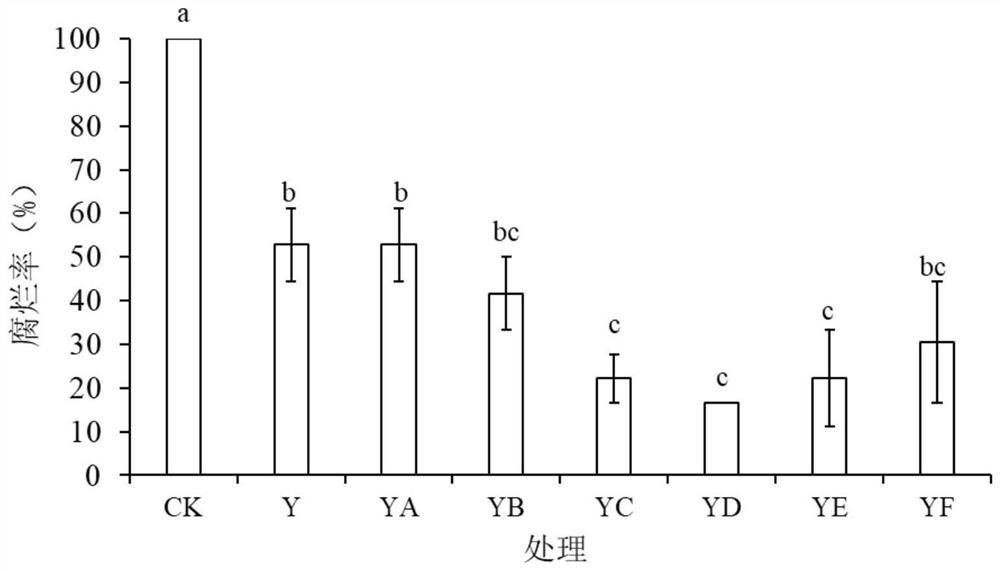The method of γ-aminobutyric acid inducing and cultivating Saccharomyces pseudopinum y16 to prevent and control postharvest diseases of grapes
A technology for aminobutyric acid and postharvest diseases, applied in the direction of microorganism-based methods, yeast-containing food ingredients, biochemical equipment and methods, etc., can solve problems such as no related reports, and achieve significant economic and social benefits, Effect of increasing antagonistic activity and reducing natural decay rate
- Summary
- Abstract
- Description
- Claims
- Application Information
AI Technical Summary
Problems solved by technology
Method used
Image
Examples
Embodiment 1
[0028] Sporidiobolus pararoseus Y16 (Sporidiobolus pararoseus Y16) is a safe and non-toxic antagonistic yeast selected from the Jurong vineyard in Zhenjiang. It is now preserved in the China General Microorganism Culture Collection and Management Center (CGMCC), and the collection number is: CGMCC No. 2.5351 (based on this yeast has applied for patent publication: CN201710753559.5 A strain of yeast for controlling postharvest penicillosis in apples and its application ).
[0029]The culture procedure is: (1) Liquid activation: Inoculate Saccharomyces pseudospora pink Y16 in NYDB medium, and cultivate at 180rpm and 28°C for 24h to obtain an activated culture solution; (2) Induction culture: step a or b can be used Steps to cultivate; a. Centrifuge the activated culture solution (8000×g, 10min) to collect the bacterial cells, repeatedly wash with sterile water to remove the medium, add an appropriate amount of sterile distilled water to count with a hemocytometer, and adjust the...
Embodiment 2
[0031] Control effect of γ-aminobutyric acid-induced Saccharomyces pyogenes Y16 on postharvest diseases caused by Aspergillus tabin.
[0032] (1) Test plan
[0033] The test variety was grape (Vitis vinifera L.), with good commercial maturity, no surface damage, no infection, and consistent specifications. The surface was rinsed with tap water, then disinfected with 0.2% (v / v) sodium hypochlorite (NaClO) for 2 min, rinsed with tap water to remove residual sodium hypochlorite, and placed in a plastic basket to dry for use.
[0034] The activation steps of mold before use are as follows: (1) Take 1 mL of mold spore suspension and inoculate it into sterilized PDB medium, and cultivate for 24 hours under a constant temperature shaker (120 rpm, 25° C.). (2) Take an appropriate amount of mold and streak on the PDA medium, cultivate in a constant temperature and humidity box for 7 days, take the mold spores on the plate in sterile saline, wash twice, and adjust to the desired concen...
Embodiment 3
[0043] Effects of γ-aminobutyric acid-induced culture of Saccharomyces sp. pseudopinum Y16 on postharvest natural rot and storage quality of grapes
[0044] (1) Test plan
[0045] The grapes with no mechanical damage, uniform size and normal commercial maturity were selected for the test. After picking, the grapes were kept in their natural condition and divided into three groups. ; (2) Yeast suspension (Y+GABA) induced by γ-aminobutyric acid supplemented medium; (3) Sterile water (as a control group, CK). After the grapes were dried at room temperature, they were individually packaged in fresh-keeping bags, then placed in plastic baskets, sealed with plastic wrap, and stored in a constant temperature and humidity incubator (20°C, RH 95%). The relative indicators of natural disease incidence and natural storage quality of fruit. Experiments were repeated three times with 3 parallels per treatment with 18 grapes per parallel. The inhibitory effect of γ-aminobutyric acid-indu...
PUM
| Property | Measurement | Unit |
|---|---|---|
| diameter | aaaaa | aaaaa |
| depth | aaaaa | aaaaa |
Abstract
Description
Claims
Application Information
 Login to View More
Login to View More - R&D
- Intellectual Property
- Life Sciences
- Materials
- Tech Scout
- Unparalleled Data Quality
- Higher Quality Content
- 60% Fewer Hallucinations
Browse by: Latest US Patents, China's latest patents, Technical Efficacy Thesaurus, Application Domain, Technology Topic, Popular Technical Reports.
© 2025 PatSnap. All rights reserved.Legal|Privacy policy|Modern Slavery Act Transparency Statement|Sitemap|About US| Contact US: help@patsnap.com



